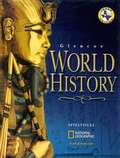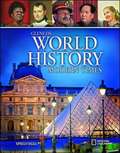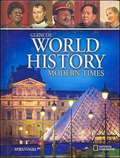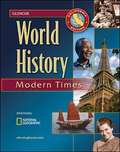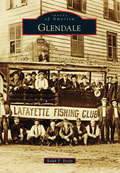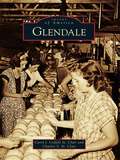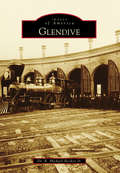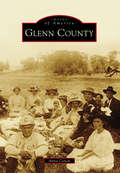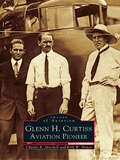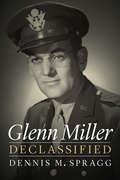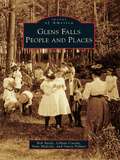- Table View
- List View
Glencoe World History (Oklahoma Edition)
by Jackson J. SpielvogelGlencoe World History focuses on the political, economic, and social events that have shaped world history. Students will be viewing and interpreting periods in world history from various perspectives, including historical, geographic, political, economic, and cultural. Together these perspectives can help them to understand how the past has led to our present and to appreciate their role in shaping our future.
Glencoe World History (Texas Edition)
by Jackson J. SpielvogelWorld history is more than just a series dramatic events. It is the story of the human, community-how people lived on a daily basis, how they shared ideas, how the) ruled and were ruled, and how they fought. World history includes big subjects like economics, politics, and social change, but it is also the story of dreams fulfilled or unfulfilled, personal creativity, and philosophical and religious inspiration.
Glencoe World History Modern Times
by Jackson J. Spielvogel McGraw-Hill StaffRecent world history in a motivating format Glencoe World History: Modern Timesdraws on the features ofGlencoe World Historyto motivate students, help them understand the connections between recent world events and issues, and give them an appreciation for the interconnectedness of the world's regions and peoples.
Glencoe World History: Modern Times
by Glencoe McGraw-Hill StaffRecent world history in a motivating forma. Glencoe World History: Modern Times draws on the features of Glencoe World History to motivate students, help them understand the connections between recent world events and issues, and give them an appreciation for the interconnectedness of the world's regions and peoples.
Glencoe World History: Modern Times
by Jackson J. SpielvogelRecent world history in a motivating format Glencoe World History: Modern Timesdraws on the features ofGlencoe World Historyto motivate students, help them understand the connections between recent world events and issues, and give them an appreciation for the interconnectedness of the world's regions and peoples..
Glencoe World History: Modern Times
by Jackson J. SpielvogelGlencoe World History: Modern Times draws on the features of Glencoe World History to motivate students, help them understand the connections between recent world events and issues, and give them an appreciation for the interconnectedness of the world's regions and peoples.
Glencoe World History: Modern Times (Alabama Edition)
by Jackson J. SpielvogelWelcome to World History Studies and to Glencoe World History: Modern Times. This course begins with a brief review of the early world history you learned in Grade 8. It then focuses on history from 1500 to the present. When you have finished your Grade 9 course, you will understand key political, social, and economic events from the past and their connection to the present. You will learn how the great explorers set the stage for European leadership and how political revolutions changed governments forever. You will also learn about the complex causes of world wars and how technology affects societies today. This knowledge will help you be a more responsible and effective citizen in your community and country. Your textbook includes a variety of tools designed to help you be successful as you study world history.
Glencoe World History: Modern Times (California Edition)
by Jackson J. SpielvogelWelcome to World History, Culture, and Geography: The Modern World and to Glencoe World History: Modern Times. The content of this course focuses on the major turning points in the shaping of the modern world, from the late eighteenth century to the present.
Glencoe World History: Modern Times (World History (hs) Ser.)
by Jackson J. Spielvogel National GeographicNIMAC-sourced textbook
Glencoe, Illinois
by Glencoe Historical Society Ellen Kettler Paseltiner Ellen ShubartGlencoe, Illinois, "Queen of Suburbs," has long been heralded as an idyllic place to live. Situated on Lake Michigan in the heart of Chicago's North Shore, Glencoe was first settled in 1835 by Anson Taylor, a young storekeeper. Glencoe began to thrive thanks to one of its famous early residents, Walter Gurnee, president of the Chicago and Milwaukee Railroad. Gurnee moved to Glencoe in the mid-1850s and in 1855 established a railroad stop across the street from his home. His presence accounts for the town's accessibility and nucleus, but it was the vision of Dr. Alexander Hammond, who arrived in Glencoe in 1867, that helped to shape it into the model suburban town it has become. It is the people of the past and present who are at the heart of this community. This collection of over 200 images captures the heart and spirit of this all-American suburb, from the village's founding and early history as a farming community and utopian settlement to the annual Fourth of July parades that continue to trumpet through the town's center.
Glencoe: The World and Its People, Eastern Hemisphere
by Richard G. Boehm Francis P. Hunkins David G. Armstrong Dennis Reinhartz Merry LobrechtThis textbook has been organized to help to learn about the many people and places that make up our world.
Glendale
by Ralph F. BradyGlendale, New York, lies just six miles from the center of the bustling metropolis of New York City but has always managed to retain its rural charm since its beginning. Taking its name from Glendale, Ohio, the town began with the unlikely occurrence of a piece of land changing hands in payment of a debt in the mid-1800s. Development of the land was slow in comparison to the surrounding communities, and many of the unoccupied parcels were bought up by people interested in building picnic parks and other types of recreational areas. Around that same time, a New York state law banned the construction of any more cemeteries in Manhattan, so Glendale's available land became equally attractive for this type of development. Glendale takes a journey back in time to the picnic parks, German biergartens, and early industries that took this community far from its origins as a farming town.
Glendale (Images of America)
by Carol J. St. Clair Charles S. St. ClairEstablished in 1892, nine miles northwest of Phoenix in the Salt River Valley of Arizona, Glendale at first attracted farmers with strong Protestant religious convictions. Soon, however, others began to settle in the town and on the rich farmlands of the area. Although predominantly Anglos, the settlers that came in the latter 1890s and early decades of the 1900s included various ethnic minorities. Each group had a significant role in the city's development into an important agricultural center that shipped produce all over the country. World War II and its influx of servicemen to train at Glendale's Luke and Thunderbird airfields brought permanent changes to Glendale. The population doubled and doubled again and again. Today the city-Arizona's fourth largest-is a metropolitan area of 59 square miles and close to 250,000 people. This volume offers windows to understanding the growth and development of Glendale over the years.
Glendive (Images of America)
by Dr R. Booker JrGlendive was founded in the early 1880s, and its growth was promoted and sustained by the Northern Pacific Railroad. Legend holds that Sir George Gore, on a hunting expedition with famed mountain man Jim Bridger, named a creek in the area Glendale Creek after a similar one in his native County Donegal, Ireland. Over the years, the word "Glendale" somehow transformed into "Glendive." Prior to the arrival of European Americans, indigenous peoples, including the Crow and the Lakota Sioux, called the area home. The arrival of the Northern Pacific in 1881, along with the passage of the Enlarged Homestead Act in 1909, lured people from America and abroad to this isolated region to pursue their version of the American dream.
Glendora (The Blackbird Trilogy #1)
by Elaine RobinsonSixteen-year-old Glendora Stamford was raised by her older brother, Thomas, after their parents died of a fever that raged through their village in Northern Wales. He adored and spoiled her. But now, the only world she knows is turned upside down when her brother receives a letter from America and suddenly announces that they are relocating there. On their journey from Wales to the English coast, to board a ship to America, Glendora discovers there is another world filled with excitement, and romance. She also experiences heartache when she is forced to remain behind. While her brother sails without her.
Glenhill Farm: The History of a Family Estate, as Revealed in the Correspondence Between Brognard Okie and Ernst and Mary Behrend
by Richard L. HartBy 1930, having developed a highly successful business, the innovative paper manufacturer Ernst Behrend and his wife Mary purchased a number of existing houses and farms to give them sufficient acreage to create a large estate. In 1948 this property became a campus of Penn State University. Known as Penn State Behrend, to this day it retains the original buildings at the historic center of the campus.Based on archival materials, including copious letters between the Behrends and their Philadelphia architect, R. Brognard Okie, this book recounts the planning and development of a unique residence as the country headed into the Great Depression. Letters between the key figures give the reader a glimpse into their thoughts and concerns, including the selection of an architect, the choice of an architectural style, issues involved in planning the estate, and the features and design of the buildings that were constructed or modified. Vintage and modern photographs help convey the nature of the buildings that Okie designed as well as a sense of the Behrends’ lifestyle in the 1930s.An absorbing microhistory of what is now Behrend College, Glenhill Farm provides a window onto a period when new money from industry supported lavish lifestyles, and it reveals how this particular project, conceived and constructed during the Great Depression, was affected by its extraordinary economic circumstances.
Glenhill Farm: The History of a Family Estate, as Revealed in the Correspondence Between Brognard Okie and Ernst and Mary Behrend
by Richard L. HartBy 1930, having developed a highly successful business, the innovative paper manufacturer Ernst Behrend and his wife Mary purchased a number of existing houses and farms to give them sufficient acreage to create a large estate. In 1948 this property became a campus of Penn State University. Known as Penn State Behrend, to this day it retains the original buildings at the historic center of the campus.Based on archival materials, including copious letters between the Behrends and their Philadelphia architect, R. Brognard Okie, this book recounts the planning and development of a unique residence as the country headed into the Great Depression. Letters between the key figures give the reader a glimpse into their thoughts and concerns, including the selection of an architect, the choice of an architectural style, issues involved in planning the estate, and the features and design of the buildings that were constructed or modified. Vintage and modern photographs help convey the nature of the buildings that Okie designed as well as a sense of the Behrends’ lifestyle in the 1930s.An absorbing microhistory of what is now Behrend College, Glenhill Farm provides a window onto a period when new money from industry supported lavish lifestyles, and it reveals how this particular project, conceived and constructed during the Great Depression, was affected by its extraordinary economic circumstances.
Glenn Beck's Common Sense
by Glenn Beck"If you believe it's time to put principles above parties, character above campaign promises, and Common Sense above all -- then I ask you to read this book...." In any era, great Americans inspire us to reach our full potential. They know with conviction what they believe within themselves. They understand that all actions have consequences. And they find commonsense solutions to the nation's problems. One such American, Thomas Paine, was an ordinary man who changed the course of history by penning Common Sense, the concise 1776 masterpiece in which, through extraordinarily straightforward and indisputable arguments, he encouraged his fellow citizens to take control of America's future -- and, ultimately, her freedom. Nearly two and a half centuries later, those very freedoms once again hang in the balance. And now, Glenn Beck revisits Paine's powerful treatise with one purpose: to galvanize Americans to see past government's easy solutions, two-part monopoly, and illogical methods and take back our great country.
Glenn County
by Anna CanonA brief look into the history of Glenn County will show you that Glenn County was created out of the northern portion of Colusa County on March 11, 1891, and was named after the prominent wheat farmer known as the "Wheat King of the World," Dr. Hugh J. Glenn. A more in-depth look at the formation of Glenn County will show that its separation from Colusa County created a fierce contest among the people of those counties. Trains filled with hundreds of citizens traveled to Sacramento to lobby the governor; a few people were even hired from outside of the county to vote for the separation. There are reports that guns were brought to the courthouse for the first election of Glenn County officials in May 1891. To this day, there remains an air of discontent between the two counties.
Glenn H. Curtiss: Aviation Pioneer (Images of Aviation)
by Kirk W. House Charles R. MitchellGlenn Curtiss beat even the Wright brothers (who sued him bitterly) to get pilot's license No. 1 in America. He teamed with Alexander Graham Bell, helped develop the moving wing part known as the aileron, introduced tricycle landing gear, made the first airplane sales, and turned aeronautics into a multimillion dollar business. His innovations ranged from the Curtiss Pusher to the hydroaeroplane, the flying boat, and the Curtiss Jenny. Curtiss, his engines, and his airplanes dominated the world of early aviation on this side of the Atlantic. Glenn H. Curtiss: Aviation Pioneer charts Curtiss's breakneck course across two continents, North America and Europe, setting speed and distance records, experimenting with military applications, always striving for a safer, faster airplane. Fostering both water flyers and shipboard landing, he became the Father of Naval Aviation. But even the skies were not wide enough for the busy brain of Curtiss. Glenn H. Curtiss: Aviation Pioneer also tracks his dizzying ride from a village bicycle shop to record-smashing motorcycle races, futuristic travel trailers, and city building in the Florida land boom.
Glenn Ligon: Untitled (I Am a Man) (Afterall Books / One Work)
by Gregg BordowitzAn illustrated examination of Glenn Ligon's iconic Untitled (I Am a Man) (1988)—a quotation, an appropriated text turned into an artifact.The iconic work Untitled (I Am a Man) (1988) by the important contemporary American artist Glenn Ligon is a quotation, an appropriated text turned into an artifact. The National Gallery of Art in Washington presents the work as a “representation—a signifier—of the actual signs carried by 1,300 striking African American sanitation workers in Memphis, made famous by Ernest Withers' 1968 photographs.” In this illustrated study of the work, Gregg Bordowitz takes the National Gallery's presentation as his starting point, considering the museum's juxtaposition of Untitled (I Am a Man) and the ca. 1935 sculpture, Schoolteacher, by William Edmondson, and the relation of the two terms, “markers” and “signs.”After closely examining the canvas itself, its textures, brushwork, and structure, Bordowitz presents a theoretical framework that draws on the work of American philosopher Charles Sanders Peirce and his theory of Firstness, Secondness, and Thirdness. He makes a case for Thirdness as a function, operation, or law of meaning-making, not limited by the gender, age, ethnicity, race, class, or personal history of the viewer. Bordowitz goes on to examine Ligon's work in terms of the representation of self, race, and gender, focusing on three series: Profile Series (1990–91), Narratives, and Runaways (both 1993). He cites such historical figures as Sojourner Truth and her famous 1851 speech, “Ain't I a Woman?” as well as influences ranging from Bo Diddley's 1955 song, “I'm a Man” to the cultural theories of Stuart Hall.
Glenn Miller Declassified
by Dennis M. SpraggOn December 15, 1944, Maj. Alton Glenn Miller, commanding officer of the Army Air Force Band (Special), boarded a plane in England bound for France with Lt. Col. Norman Francis Baessell. Somewhere over the English Channel the plane vanished. No trace of the aircraft or its occupants has ever been found. To this day Miller, Baessell, and the pilot, John Robert Stuart Morgan, are classified as missing in action. Weaving together cultural and military history, Glenn Miller Declassified tells the story of the musical legend Miller and his military career as commanding officer of the Army Air Force Band during World War II. After a brief assignment to the Army Specialist Corps, Miller was assigned to the Army Air Forces Training Command and soon thereafter to Supreme Headquarters, Allied Expeditionary Force, in the UK. Later that year Miller and his band were to be transferred to Paris to expand the Allied Expeditionary Forces Programme, but Miller never made it. Miller’s disappearance resulted in numerous conspiracy theories, especially since much of the information surrounding his military service had been classified, restricted, or, in some cases, lost. Dennis M. Spragg has gained unprecedented access to the Miller family archives as well as military and government documents to lay such theories to rest and to demonstrate the lasting legacy and importance of Miller’s life, career, and service to his country.
Glennville (Images of America)
by Glennville-Tattnall MuseumThe area that would become modern Glennville was first opened to settlement in 1773. In the early decades of the 19th century, settlers converged around the intersection of Hencart Road and Reidsville-Johnston's Station Road. The community that grew around this intersection came to be known as Philadelphia--a name it would hold until 1889, when the village's first post office was established. The village was then renamed after a prominent schoolteacher and minister, Glenn Thompson, who was instrumental in securing the post office for the village. Glennville was incorporated as a town in 1894 and continued to grow remarkably through the coming decades until it became the commercial and agricultural hub of Tattnall County.
Glens Falls People and Places
by Gwen Palmer Stan Malecki Bob Bayle Lillian CasolaThe name Glens Falls went through a series of changes, beginning simply as "the Corners," after a bend in the road from a major military installation in Fort Edward. In the 1700s, it was known as Wing's Falls, and later Pearlville, Pearl Village, and Glenn's Falls; but by the middle of the 1800s, it was determined to be Glens Falls, one of the wealthiest villages in the state. It was the people who settled in the town that helped to shape it. The lumber barons provided the financial backing to begin banking and insurance institutions and served as officers of every major business and governmental agency in town. Glens Falls People and Places covers the lives of the prosperous and preposterous people and their contributions to the city's development through the 20th century.

